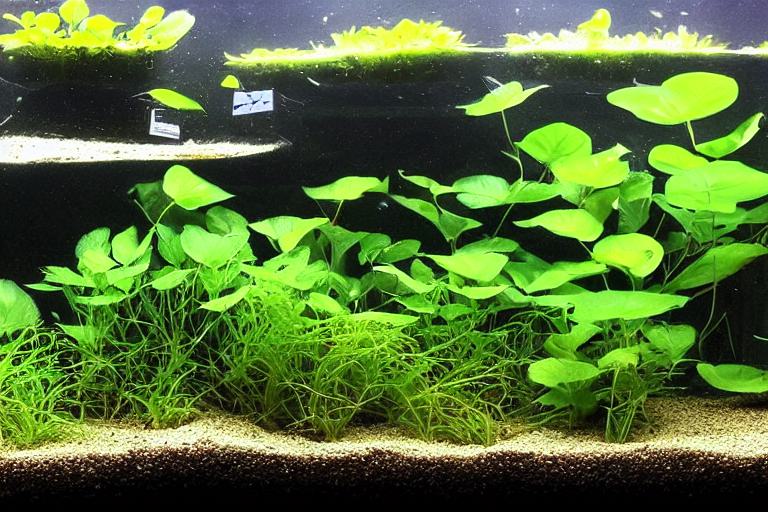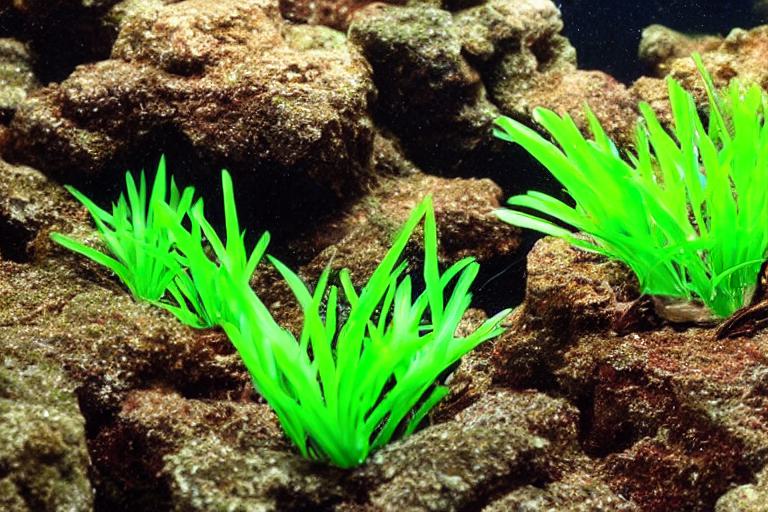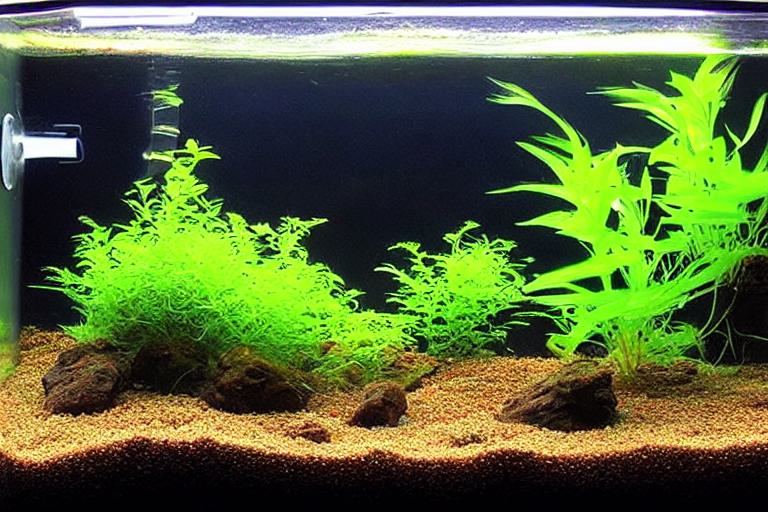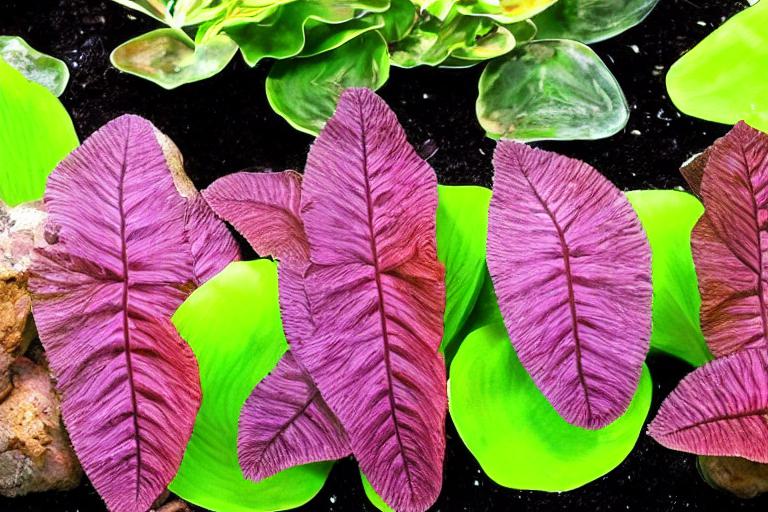If you’re looking for some easy live plants for your aquarium that don’t need CO2, you’ve come to the right place. In this article, we’ll show you 20 of the best options that are low-maintenance and will thrive in your tank.
1. Java Fern
Java Fern can be attached to driftwood or rocks and will spread over time. Java Fern is a popular plant for aquariums because it is relatively easy to care for and does not require CO2. Java Fern is a slow-growing plant, so it is not recommended for aquariums with fast-moving fish. This plant can tolerate a wide range of lighting conditions and does not require fertilization.


2. Anubias
They do not require CO2 and can tolerate a wide range of water conditions. Anubias is an excellent choice for aquariums because they are very easy to care for. Anubias can be attached to rocks or driftwood and will add a beautiful, natural look to your aquarium.


Different Types of Anubias
There are many different types of Anubias, so you can find one that fits your aquarium. One of the most popular aquarium plants is Anubias. This is because they are very easy to care for and don’t need CO2.
It is a great plant for beginners because it is very hardy. This plant is very easy to care for and can grow in both low and high light conditions. The most common type of Anubias is the Anubias barteri.
This plant is very similar to the Anubias barteri, but it is smaller. If you are looking for a plant that can grow in low light conditions, then you should consider the Anubias nana. It is a great plant for nano aquariums.
This plant grows very fast and can get very big. If you are looking for a plant that can grow in high light conditions, then you should consider the Anubias Congensis. It is a great plant for larger aquariums.

3. Vallisneria
Vallisneria is a genus of freshwater aquatic plants, often called eelgrass or tape grass. Vallisneria is a popular plant for aquariums and aquascaping because it is relatively easy to care for and does not require CO2 injection or high light levels to thrive. The plants produce long, ribbon-like leaves that can be either green or brown in color. The genus is native to temperate and tropical regions of the world and contains about 50 species. Vallisneria can grow to be quite large, reaching heights of up to 2.5 meters in some species. Vallisneria is a fast-growing plant and can quickly spread to cover a large area of an aquarium.


Propagating Vallisneria
Vallisneria, also known as eelgrass or tape grass, is a popular plant for freshwater aquariums. It is relatively easy to care for and can be propagated by dividing the root mass.
Plant each section in a separate pot or container filled with aquarium gravel or sand. Carefully remove the plant from the aquarium and divide the root mass into 2-3 sections. To propagate Vallisneria, start with a healthy plant that has a good root system.
Keep the plants well-watered and fertilized, and they should quickly start to grow. Place the pots or containers in the aquarium, making sure that the roots are buried and the plant is securely anchored.
With a little care and patience, you can easily propagate Vallisneria and add more greenery to your aquarium.

Different types of Vallisneria
If you’re looking for an easy live plant for your aquarium that doesn’t need CO2, Vallisneria is a great option. There are many different types of Vallisneria, so you can choose the one that best suits your aquarium.
Some of the most popular types of Vallisneria include:
Vallisneria americana: This type of Vallisneria is also known as eelgrass or tape grass. It’s a fast-growing plant that can reach up to 2 feet in length. Vallisneria americana is a good choice for beginners because it’s easy to care for.
Vallisneria asiatica: This type of Vallisneria is also known as Chinese water celery. It’s a slower-growing plant that only reaches about 1 foot in length. Vallisneria asiatica is a good choice for aquariums with slow-moving fish, as it can help to oxygenate the water.
It’s a fast-growing plant that can reach up to 3 feet in length. Vallisneria spiralis: This type of Vallisneria is also known as Italian valisneria. Vallisneria spiralis is a good choice for beginners because it’s easy to care for.
Vallisneria gigantea is a good choice for aquariums with slow-moving fish, as it can help to oxygenate the water. It’s a slower-growing plant that only reaches about 2 feet in length. Vallisneria gigantea: This type of Vallisneria is also known as giant valisneria.
4. Moss
Moss is an excellent addition to any aquarium as it provides a natural, lush look. Moss is a type of plant that can be found in a variety of environments, from damp forest floors to the shady areas in your aquarium. Moss is also a great plant for beginners as it is very easy to care for and does not require any special attention.

Java Moss
Java moss can be attached to rocks or driftwood and will grow in both low and high light conditions. Java moss is a plant that is native to Southeast Asia. It is a popular plant for aquariums because it does not need CO2 and it is easy to care for. This plant is also a good choice for breeding tanks because it provides cover for fry.
“Planting” Java Moss
Java moss is an easy plant to care for and is a great addition to any aquarium. It can be planted in a number of different ways and will thrive in most conditions.
To plant java moss, simply tie it to a piece of driftwood or rocks using fishing line or a rubber band. Once it is in place, the java moss will start to grow and spread. Make sure the java moss is secure and that there are no gaps where it can escape.
Fill the pot with aquarium gravel or sand and then add the java moss. Be sure to keep the pot moist but not wet. The java moss will eventually start to grow out of the pot and can be trimmed back as needed. Java moss can also be grown in a pot or container.
It is a great plant for beginners and experienced aquarium owners alike. Java moss is a hardy plant that doesn’t require much care.

Care for Java Moss
Java moss is one of the most popular aquarium plants, and it’s easy to see why. Java moss is easy to care for and can thrive in a wide range of aquarium conditions.
Java moss is a low-light plant, so it doesn’t require intense lighting to thrive. It can also tolerate a wide range of water conditions, making it a great plant for beginners. Java moss is a slow-growing plant, so it doesn’t require frequent trimming.
Java moss will gradually spread over time. You can trim java moss to keep it under control, or allow it to grow into a dense, lush carpet. To care for java moss, simply attach it to a piece of driftwood or rocks using fishing line or a rubber band.
5. Cryptocoryne
Cryptocoryne is a relatively easy genus of plants to grow, and many species will thrive in a wide range of aquarium conditions. Cryptocoryne is a genus of aquatic plants that are native to Sri Lanka and South India. Cryptocoryne is a popular genus of aquarium plants, and many species are commonly kept by aquarists.
Cryptocoryne is a relatively easy genus of plants to grow, and many species will thrive in a wide range of aquarium conditions. Cryptocoryne is a genus of aquatic plants that are native to Sri Lanka and South India. Cryptocoryne is a popular genus of aquarium plants, and many species are commonly kept by aquarists.
Cryptocoryne is a relatively easy genus of plants to grow, and many species will thrive in a wide range of aquarium conditions. Cryptocoryne is a genus of aquatic plants that are native to Sri Lanka and South India. Cryptocoryne is a popular genus of aquarium plants, and many species are commonly kept by aquarists.

Different kind of Cryptocoryne
There are approximately 60 species of Cryptocoryne, and they come in a variety of colors and sizes. Cryptocoryne is a popular plant for aquariums because it is relatively easy to care for and does not require CO2. Cryptocoryne is a genus of aquatic plant that is native to Sri Lanka and India.
Cryptocoryne wendtii is a slow-growing plant, so it is perfect for beginners. It is a dark green plant with ruffled leaves. Cryptocoryne wendtii is one of the most popular species of Cryptocoryne.
Cryptocoryne beckettii is another popular species of Cryptocoryne. Cryptocoryne beckettii grows quickly and can reach up to 12 inches in height. It is a bright green plant with narrow leaves.
It is a dark green plant with small, round leaves. Cryptocoryne parva is a miniature species of Cryptocoryne that only grows to about 2-3 inches in height. Cryptocoryne parva is perfect for nano aquariums.

Planting Cryptocoryne
Cryptocoryne is a popular genus for aquariums because they are relatively easy to care for and do not require CO2 injection. The plants in this genus are commonly called water trumpets. Cryptocoryne is a genus of aquatic plants that are native to Sri Lanka and India.
If the rhizomes are allowed to dry out, the plants will not survive. When dividing the plants, it is important to replant them immediately into their new pots or aquariums. Cryptocoryne plants can be propagated by division or by planting their rhizomes.
They will also do well in a mixture of both. Cryptocoryne plants prefer a substrate of sand or gravel. The plants should be fertilized with a liquid fertilizer that is high in iron.
Cryptocoryne plants are relatively easy to care for and make a great addition to any aquarium. With a little bit of care, they will thrive and add beauty to your underwater world.
6. Amazon Swords
Amazon Swords are one of the most popular live plants for aquariums. They are easy to care for and don’t need CO2. Amazon Swords are a great addition to any aquarium.

7. Water Weeds (Elodea)
Elodea is very easy to care for and does not require any special care. Elodea is a common water weed that is often used in aquariums. It can be used as a background plant, a foreground plant, or even a floating plant. It is a very hardy plant and can tolerate a wide range of water conditions. It is a fast-growing plant that can quickly take over an aquarium if left unchecked. Elodea is a very versatile plant and can be used in a variety of ways in an aquarium.

8. Bucephalandra
Bucephalandra is a slow growing plant, so it is perfect for those who do not want to deal with fast growing plants. This plant is also very tolerant to a wide range of water conditions, so it is perfect for those who are just starting out with live plants. Bucephalandra is a beautiful and unique live plant that is perfect for any aquarium. This plant does not require CO2 and is very easy to care for.

9. Dwarf Sagittaria
If you’re looking for an easy live plant for your aquarium that doesn’t need CO2, look no further than Dwarf Sagittaria. This plant is perfect for beginners, as it’s relatively easy to care for and doesn’t require any special attention.
Dwarf Sagittaria is a great addition to any aquarium, as it provides cover and hiding places for fish. It also helps to oxygenate the water and can absorb excess nutrients from the water, making it a great choice for a low-maintenance aquarium.
This plant can be found in most pet stores that sell aquarium plants, and it’s a great choice for anyone looking for an easy-to-care-for plant that doesn’t require CO2.
10. Hornwort
It is best to trim it back regularly to keep it under control. It can grow in a wide range of lighting conditions and does not require CO2. Hornwort is an excellent plant for beginners because it is very easy to care for. Hornwort is a fast-growing plant and can quickly become too large for a small aquarium.

11. Hygrophila Polysperma
It is a popular aquarium plant due to its easy care and tolerance of a wide range of water conditions. Hygrophila polysperma, also known as Indian swampweed, is a fast-growing freshwater plant native to India. Hygrophila polysperma can be found in a variety of colors, including green, red, and brown.
Hygrophila polysperma is a fast-growing plant, so it is ideal for filling in empty spaces in the aquarium. This plant is a great choice for beginners due to its ease of care. This plant is available in a variety of colors, so it can be used to create a beautiful, natural-looking aquarium. It can be grown in a wide range of water conditions and does not require CO2.

12. Water Wisteria
Water Wisteria can be found in most pet stores that sell live plants. This plant does not require CO2 and is very easy to propagate. Water Wisteria is a beautiful and easy to care for live plant that is perfect for any aquarium.

13. Ludwigia Repens
Ludwigia Repens is a beautiful live plant that is perfect for any aquarium. This plant does not need CO2 and is very easy to care for. Ludwigia Repens will add a splash of color to your aquarium and is a great addition to any fish tank.

14. Brazilian Pennywort
If you’re looking for a low-maintenance plant for your aquarium, Brazilian pennywort is a great option. This fast-growing plant can reach lengths of up to 2 feet, making it a great choice for filling in empty spaces. Brazilian pennywort is also a good oxygenator, which can help to improve water quality in your aquarium.
15. Water Lettuce
Water lettuce is a floating plant that is native to Africa. It is best suited to larger aquariums where it can be allowed to spread out. Water lettuce is a fast-growing plant and can quickly become a nuisance in an aquarium if not kept in check. It has long, thin leaves that are arranged in a rosette. The leaves are covered in tiny hairs that help the plant to trap air and float on the water surface.
Water lettuce is a great plant for beginners as it is very easy to care for. It does not require any special attention or care and will do well in most aquariums. It is a good plant for oxygenating the water and providing hiding places for fish.

16. Water Spangles
Water spangles are great for beginners because they’re very hardy. They’re easy to grow and don’t require CO2. Water spangles (Hydrilla verticillata) are one of the most common aquatic plants in the world. They can grow in a wide range of water conditions and can tolerate low light levels.
They have long, slender leaves that are arranged in whorls around the stem. They’re typically green, but they can also be found in shades of red, brown, and purple. Water spangles are fast-growing plants that can quickly take over an aquarium. Water spangles can grow up to 2 feet tall in an aquarium.
You can propagate them by taking cuttings from the plant and planting them in the substrate. Water spangles can also be propagated by dividing the plant. Water spangles are easy to propagate.

17. Marimo Moss Balls
These algae balls are a great way to naturally filter your aquarium water and provide hiding places for small fish. These balls are a popular addition to aquariums because they are easy to care for and add a pop of green to the tank. Marimo moss balls are low-maintenance and can live in a variety of water conditions. Marimo moss balls are a type of algae that forms into a green, fuzzy ball.

18. Red Tiger Lotus
It’s a relatively easy plant to care for, and doesn’t require CO2. If you’re looking for a plant that will add some color to your aquarium, the red tiger lotus is a great option. The red tiger lotus is a fast-growing plant, and can reach up to 18 inches in height. This plant gets its name from its bright red leaves, which are accented by black spots.

19. Moneywort
This fast-growing plant can reach up to 12 inches in height and produces small, white flowers. Moneywort is a great choice for both beginners and experienced aquarium hobbyists alike. If you’re looking for an easy-to-care-for live plant for your aquarium that doesn’t need CO2, moneywort (Bacopa monnieri) is a great option.

20. Micro Swords
Micro Swords are a low-light plant, so they don’t require much in the way of lighting. They can be a little tricky to grow, but once they get going, they’re relatively easy to care for. Micro Swords (Lilaeopsis brasiliensis) are perfect for the foreground of your aquarium. They stay relatively small, only reaching about 2-3 inches in height, and have very fine leaves.

To conclude
To conclude, here are 20 easy live plants for your aquarium that don’t need CO2. These plants are perfect for beginners and will help to create a healthy and balanced ecosystem in your aquarium.
References
These 20 easy live plants don’t need CO2 and will thrive in a variety of aquarium conditions. If you’re looking for some low-maintenance live plants for your aquarium, you’ve come to the right place.
From fast-growing plants like hornwort and java fern to floating plants like water sprite and duckweed, there’s something for everyone. And the best part is that these plants are easy to care for and don’t require any special equipment or fertilizers.
So if you’re looking for some beautiful, easy-to-care-for live plants for your aquarium, be sure to check out these 20 options.
Frequently Asked Questions
1. What are some easy live plants for my aquarium that don’t need CO2?
There are a number of easy live plants that don’t need CO2 in order to thrive. Some good options include Anubias, Java Fern, and Hornwort.
2. How do I know if my plant needs CO2?
If you are unsure whether or not your plant needs CO2, you can consult a reliable source, such as an experienced aquarium owner or a professional at a local fish store.
3. What are the benefits of having live plants in my aquarium?
Live plants can provide a number of benefits to your aquarium. They can help to oxygenate the water, provide hiding places for fish, and help to keep the water clean.
4. What are some things I should consider before adding live plants to my aquarium?
Before adding live plants to your aquarium, you should consider the size of your aquarium, the type of fish you have, and the amount of light that is available.
5. How do I care for live plants in my aquarium?
Caring for live plants in your aquarium is relatively easy. Most plants only need to be fertilized once a week and should be given a light trimming every few weeks.
Final thoughts
Aquatic plants are a beautiful and natural addition to your aquarium, and they can also help to improve water quality. There are many easy-to-care-for live plants that don’t require CO2, and these 20 species are a great place to start. With a little research and care, you can have a thriving aquatic plant community in your aquarium.
